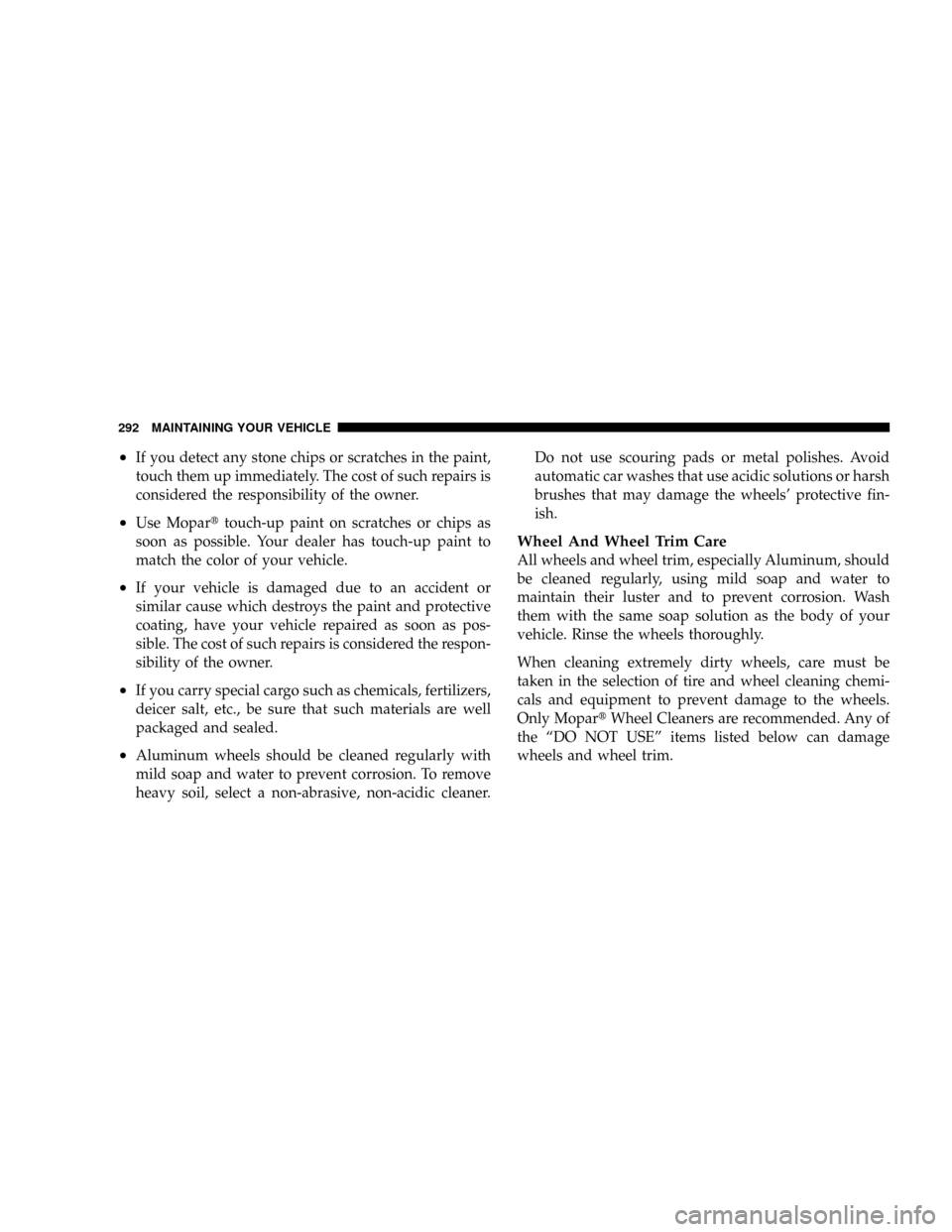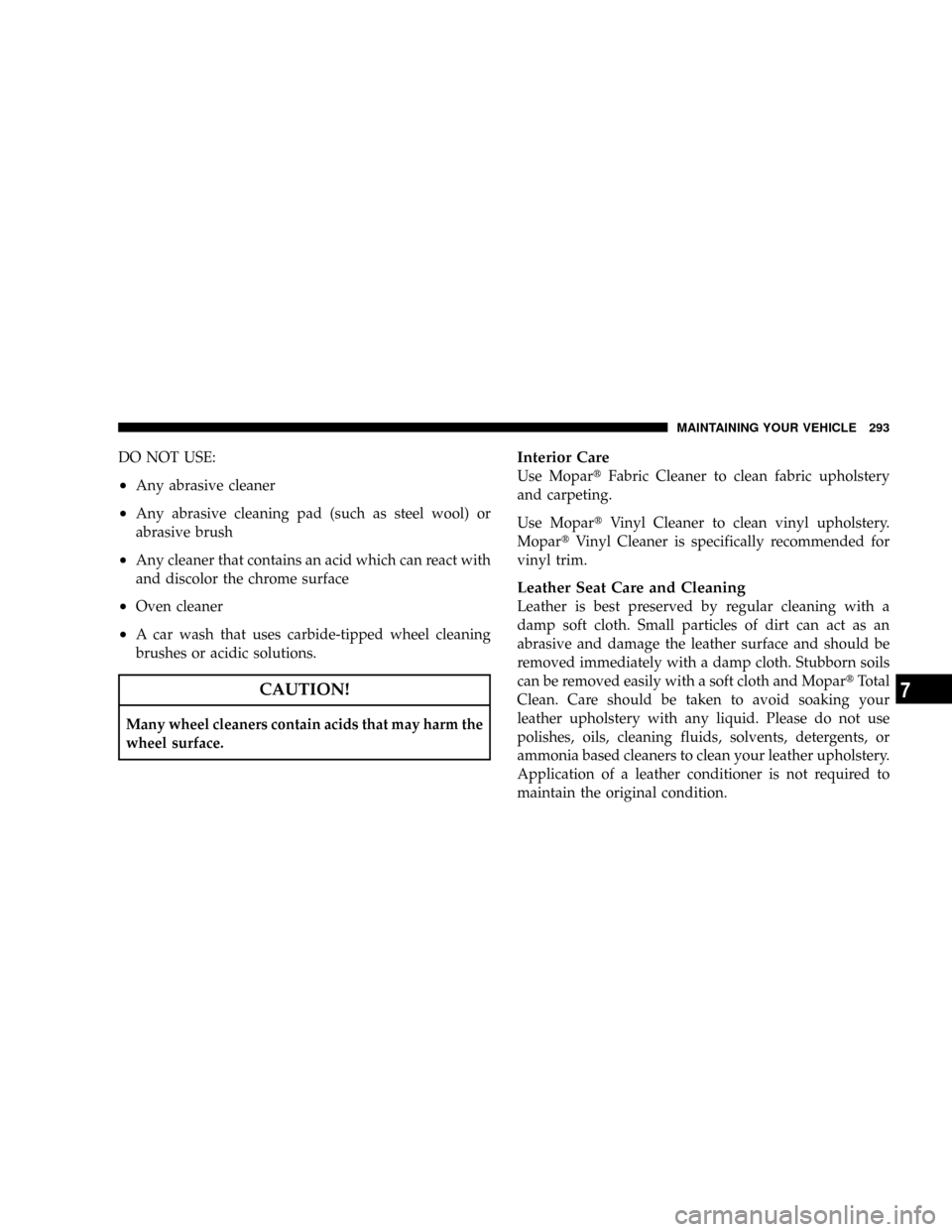Page 289 of 358
Use brake fluid approved to MB 331.0, or a DOT 4 brake
fluid with: minimum dry boiling point (ERBP) 500ÉF,
minimum wet boiling point (WERBP) 356ÉF, maximum
viscosity 1500 mm
2/s, conforming to FMVSS 116 and
ISO 4925.
WARNING!
Use of a brake fluid that may have a lower initial
boiling point or unidentified as to specification, may
result in sudden brake failure during hard prolonged
braking. You could have an accident.
WARNING!
Use only brake fluid that has been in a tightly closed
container to avoid contamination from foreign mat-
ter. Use of contaminated fluid may result in reduced
brake performance or a sudden brake failure. You
could have an accident.
CAUTION!
Do not allow petroleum-based fluid to contaminate
the brake fluid as seal damage will result!
MAINTAINING YOUR VEHICLE 287
7
Page 291 of 358

Fluid and Filter Changes
Automatic transmission fluid and filter should be
changed at 80,000 mi (129 000 km). The fluid is then filled
for life.
NOTE:Refer to Section 8 of this manual for Mainte-
nance Schedules.
Manual Transmission
Selection of Lubricant
No fluid service is required. Use only fluid approved to
MB 236.2. SAE 5W-20 engine oil, meeting API SL or GF-3,
may be substituted. Refer to the Recommended Fluids,
Lubricants and Genuine Parts section for the correct fluid
type.
Fluid Level Check
Check the fluid level by removing the fill plug. The fluid
level should be between the bottom of the fill hole and a
point not more than 3/16 in (4.76 mm) below the bottom
of the hole.
CAUTION!
Do not overfill. Dirt and water in the transmission
can cause serious damage. To prevent dirt and water
from entering the transmission after checking or
replenishing fluid, make certain that the dipstick cap
is seated properly.
Add fluid, if necessary, to maintain the proper level.
MAINTAINING YOUR VEHICLE 289
7
Page 294 of 358

²If you detect any stone chips or scratches in the paint,
touch them up immediately. The cost of such repairs is
considered the responsibility of the owner.
²Use Moparttouch-up paint on scratches or chips as
soon as possible. Your dealer has touch-up paint to
match the color of your vehicle.
²If your vehicle is damaged due to an accident or
similar cause which destroys the paint and protective
coating, have your vehicle repaired as soon as pos-
sible. The cost of such repairs is considered the respon-
sibility of the owner.
²If you carry special cargo such as chemicals, fertilizers,
deicer salt, etc., be sure that such materials are well
packaged and sealed.
²Aluminum wheels should be cleaned regularly with
mild soap and water to prevent corrosion. To remove
heavy soil, select a non-abrasive, non-acidic cleaner.Do not use scouring pads or metal polishes. Avoid
automatic car washes that use acidic solutions or harsh
brushes that may damage the wheels' protective fin-
ish.
Wheel And Wheel Trim Care
All wheels and wheel trim, especially Aluminum, should
be cleaned regularly, using mild soap and water to
maintain their luster and to prevent corrosion. Wash
them with the same soap solution as the body of your
vehicle. Rinse the wheels thoroughly.
When cleaning extremely dirty wheels, care must be
taken in the selection of tire and wheel cleaning chemi-
cals and equipment to prevent damage to the wheels.
Only MopartWheel Cleaners are recommended. Any of
the ªDO NOT USEº items listed below can damage
wheels and wheel trim.
292 MAINTAINING YOUR VEHICLE
Page 295 of 358

DO NOT USE:
²Any abrasive cleaner
²Any abrasive cleaning pad (such as steel wool) or
abrasive brush
²Any cleaner that contains an acid which can react with
and discolor the chrome surface
²Oven cleaner
²A car wash that uses carbide-tipped wheel cleaning
brushes or acidic solutions.
CAUTION!
Many wheel cleaners contain acids that may harm the
wheel surface.
Interior Care
Use MopartFabric Cleaner to clean fabric upholstery
and carpeting.
Use MopartVinyl Cleaner to clean vinyl upholstery.
MopartVinyl Cleaner is specifically recommended for
vinyl trim.
Leather Seat Care and Cleaning
Leather is best preserved by regular cleaning with a
damp soft cloth. Small particles of dirt can act as an
abrasive and damage the leather surface and should be
removed immediately with a damp cloth. Stubborn soils
can be removed easily with a soft cloth and MopartTotal
Clean. Care should be taken to avoid soaking your
leather upholstery with any liquid. Please do not use
polishes, oils, cleaning fluids, solvents, detergents, or
ammonia based cleaners to clean your leather upholstery.
Application of a leather conditioner is not required to
maintain the original condition.
MAINTAINING YOUR VEHICLE 293
7
Page 299 of 358

The following methods are sufficient if the top is only
lightly soiled:
Dry Cleaning
Brush the dry top with a soft-bristled brush from front to
rear of the vehicle.
Wet Cleaning
Wash with clear water or with a mild detergent and an
ample supply of luke warm water by wiping with a
soft-bristled brush or sponge from front to rear. Then
rinse thoroughly with clear water.
Allow the top to dry before lowering. Vacuuming the top
with a wet/dry shop vacuum will decrease the top's
drying time, ensure removal of all dirt, and delete streaks
in the material. Multiple cleanings may be necessary to
remove stubborn stains. If stains persist, contact your
local dealership for further suggestions.
Weather Strip Care
Lubricate all top and door glass weather strips periodi-
cally with Mopar Weather Strip Lubricant (part number
4773427), to keep them soft and pliable.
FUSES
Underhood Accessory Fuse Block Fuses
The underhood accessory fuse block fuses are located
under the hood on the driver's side, between the brake
master cylinder and the left front fender.
To remove the lid, squeeze the tabs together located at the
front of the fusebox. Then lift the lid up by the tabs. The
lid will then slide off the top of the fuse box. To replace
the lid, place the two hinge-like tabs at the rear of the lid
under the tabs on the fusebox. Push down on the front of
the lid until the tabs at the front click.
MAINTAINING YOUR VEHICLE 297
7
Page 302 of 358
Cavity Fuse Circuits
6 40 Amp
OrangeRoof Hydraulic Unit (Roadster)
7 5 Amp
BeigeOccupation Classification Module
(Right Seat)
8 15 Amp
BlueRadio
9 5 Amp
BeigeControl Unit Airbag
10 5 Amp
BeigeSpeed Control
11 15 Amp
BlueIgnition Coil 6 Cyl.
12 10 Amp
RedWasher Liquid Heater, Washer
Nozzle Heater
13 10 Amp
RedRoof Light, Horn, Anti-Theft-
Alarm, Trunk Light and Tire
Pressure ControlCavity Fuse Circuits
14 10 Amp
RedDiagnostic Socket
15 5 Amp
BeigeClimate Control, Auxiliary Water
Pump
16 10 Amp
RedSpoiler Motor
17 40 Amp
OrangeElectronic Stability Program
18 40 Amp
OrangeElectronic Stability Program
19 40 Amp
OrangePower Window, Front
20 30 Amp
GreenWiper Motor
21 30 Amp
GreenSeat Adjustment Right Side
22 30 Amp
GreenSeat Adjustment Left Side
300 MAINTAINING YOUR VEHICLE
Page 309 of 358
CAUTION!
Do not touch the new bulb with your fingers. Oil
contamination will severely shorten bulb life. If the
bulb comes in contact with an oily surface, clean the
bulb with rubbing alcohol.
Front Turn Signal and Parking/Standing Lights
²
Twist the bulb socket counterclockwise and pull out.
Push the bulb into the socket, turn counterclockwise
and remove.
²Replace the bulb, push in and twist clockwise. Rein-
stall the socket, and turn clockwise.
Front and Rear Sidemarker Lights
1. Push the front sidemarker assembly in and slide it
forward. Push the rear sidemarker assembly in and slide
rearward. The assembly will release from the fascia.
2. Twist the bulb socket counterclockwise and pull out.
Push the bulb into the socket, turn counterclockwise and
remove.
3. Replace the light, push in and twist clockwise.
MAINTAINING YOUR VEHICLE 307
7
Page 313 of 358

VEHICLE STORAGE
We recommend that you follow these guidelines before
storing your vehicle for extended periods.
²Fill the gas tank. This will prevent water condensation
inside the tank. If you plan on storing your vehicle
more than two months, add an anti-oxidant fuel
stabilizer to the gas tank.
²Change the oil to remove any corrosive combustion-
related acids in the crankcase.
²Wash and wax the vehicle to protect the finish.
²Cover the vehicle whenever possible to prevent acci-
dental damage to the finish.
²Store the vehicle in a dry, well-ventilated location.
²If the vehicle will be subjected to freezing tempera-
tures, remove the battery and store it in a dry, well-
ventilated place. If the vehicle is not going to be driven
in the next three weeks, follow the battery recharge
procedure in the Service Manual, then disconnect the
battery at the negative terminal.
CAUTION!
Use care when disconnecting the remote positive
cable. It is connected to the battery and can short out
to any metal on the vehicle. Always tape or wrap the
exposed cable end to prevent electrical shorts.
Disconnecting the battery causes the engine control sys-
tem to lose memory of some ªlearnedº functions. The
engine may run rough when first started after a battery
disconnect until the control module ªrelearnsº these
functions.
MAINTAINING YOUR VEHICLE 311
7